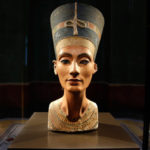 Creepy
Creepy  Creepy
Creepy  Technology
Technology 10 Scientific Breakthroughs of 2025 That’ll Change Everything
 Our World
Our World 10 Ways Icelandic Culture Makes Other Countries Look Boring
 Misconceptions
Misconceptions 10 Common Misconceptions About the Victorian Era
 Mysteries
Mysteries 10 Strange Unexplained Mysteries of 2025
 Miscellaneous
Miscellaneous 10 of History’s Most Bell-Ringing Finishing Moves
 History
History 10 Great Escapes That Ended Right Back in Captivity
 Weird Stuff
Weird Stuff 10 Fascinating Things You Might Not Know About Spiders
 Food
Food 10 Everyday Foods You Didn’t Know Were Invented by the U.S. Military
 History
History 10 Odd Things Colonial Americans Kept at Home
 Creepy
Creepy 10 More Representations of Death from Myth, Legend, and Folktale
 Technology
Technology 10 Scientific Breakthroughs of 2025 That’ll Change Everything
 Our World
Our World 10 Ways Icelandic Culture Makes Other Countries Look Boring
Who's Behind Listverse?

Jamie Frater
Head Editor
Jamie founded Listverse due to an insatiable desire to share fascinating, obscure, and bizarre facts. He has been a guest speaker on numerous national radio and television stations and is a five time published author.
More About Us Misconceptions
Misconceptions 10 Common Misconceptions About the Victorian Era
 Mysteries
Mysteries 10 Strange Unexplained Mysteries of 2025
 Miscellaneous
Miscellaneous 10 of History’s Most Bell-Ringing Finishing Moves
 History
History 10 Great Escapes That Ended Right Back in Captivity
 Weird Stuff
Weird Stuff 10 Fascinating Things You Might Not Know About Spiders
 Food
Food 10 Everyday Foods You Didn’t Know Were Invented by the U.S. Military
 History
History 10 Odd Things Colonial Americans Kept at Home
10 Things We Have Learned about Historical Figures from Hair
The hobby of collecting hair may seem strange, but this curious commodity has come in handy for modern historians with access to DNA analysis techniques. Testing hair has produced many historical insights which would otherwise have been impossible without disturbing the resting places of the deceased. While DNA information has been useful in solving disputes over lineage, it has also been able to teach us much about the lives and deaths of famous figures. Here are 10 things we have learned from the hair of some well-known people—and one cryptid.
Related: 10 Shocking Discoveries We Uncovered From Analyzing Ancient DNA
10 Beethoven’s Illness
This incomparable composer suffered from more than his well-documented deafness. His ailments were so severe he asked doctors to study his health problems after he died, which he did at the relatively early age of 56. Beethoven frequently suffered from stomach problems that remained undiagnosed long after his death. It is believed they disrupted his ability to compose at times.
Progress into the cause of his illness was finally made almost 200 years later in 2023 when researchers extracted DNA from preserved locks of Beethoven’s hair. It took a lot of hair to do so—10 feet (3 meters) in total, and each strand had to be individually cleaned.
However, testing revealed that Beethoven’s genetic risk for liver disease, combined with his drinking, could have caused his bad health and may have resulted in fatal liver failure. They also discovered he had hepatitis B in his final months, although they have yet to solve the mysterious cause of the composer’s deafness.[1]
9 Why George III Went Mad
England’s most famous mad monarch was not always so—his odd behaviors were episodic. Some days during his long reign between 1760 and 1820 saw his majesty nonsensically babbling, assaulting people in his court, and having hallucinations. Outside of these episodes, the king could recognize his own madness, moving him to tears. The cause of his inconsistent insanity remained a mystery after he died. Some suggested psychosis, others lead poisoning.
One theory put forth in 1969 suggested the king had porphyria, a rare hereditary condition first identified in the 20th century. People with porphyria can experience confusion, hallucinations, paranoia, and other symptoms of mental illness. However, it is actually caused by the insufficiency of a compound found in red blood cells. Only 10% of people with the right genes actually suffer from porphyria, but known triggers include stress, sun exposure, and arsenic. The latter is the most important in this case.
In 2005 scientists tested surviving locks of the king’s hair and discovered elevated levels of lead and arsenic. Combined with porphyria diagnosed in some of his descendants, this provides a plausible explanation for the king’s illness. But where did the arsenic come from? The original physician’s notes reveal it was in the medicine, which was making the king more mad.[2]
8 Eva Braun’s Jewish Ancestry
Hitler could have unknowingly married a Jew—this was the ironic conclusion reached in 2014 by a team working on a controversial British documentary series. They tested hairs that are believed to have belonged to Braun, Hitler’s long-time mistress and short-time wife. The hairs came from a brush found inside a monogrammed cosmetic case in Braun’s apartment. It was taken by an American intelligence officer after the war.
The analysis revealed she possessed a particular genome that is very strongly associated with Ashkenazi Jews. Many Ashkenazi Jews in Europe had converted to Catholicism by the 19th century, which could explain why neither Braun nor Hitler was aware of her ancestry.
However, while the hairbrush was declared authentic by experts, there was no way to definitively prove the hairs on it came from Eva Braun as her surviving relatives refused to provide DNA samples. But it is highly probable to have been hers and provides compelling evidence which strikes at the heart of Hitler’s ideas of racial superiority.[3]
7 King Louis XVII Died in Prison
King Louis XVII was the son of Louis XVI and Marie Antoinette, the French royals beheaded by the guillotine during the French Revolution. Aged eight, he technically became king of France immediately upon his father’s execution, but he had already been imprisoned by the revolutionaries under appalling conditions. At the age of only ten, he died of tuberculosis.
Upon his death, Louis’s heart was cut from his body and stored in the Saint-Denis cathedral, but for a long time, some people did not believe he had died. They believed he had escaped his captors and produced heirs to continue the royal bloodline. If this had been proven to be true in the following centuries, it could have thrown France into a civil war between royalists and republicans.
However, in 2004, this theory was at last laid to rest along with the unfortunate king himself. DNA analysis from a lock of Marie Antoinette’s hair and other samples from relatives of the boy’s family confirmed that the heart did belong to him and that he must have died in prison. Exactly 209 years after his death, he was given a proper burial ceremony at the cathedral, and his heart was laid to rest in the royal crypt with his parents.[4]
6 Why Elvis Died Young
While it is widely known that Elvis Presley died of a heart attack, as well as his whereabouts when he had it, the cause of the attack, which killed the King of rock n’ roll at only 42 years old, remained a mystery for several decades. People were quick to point the finger at his late lifestyle, especially his overeating. Although this was certainly harmful, later evidence showed that this was no smoking gun.
When what was believed to have been Elvis’s hair (procured from a friend of his barber) underwent DNA analysis, the results showed a mutation known to cause migraines, glaucoma, and obesity. These align with the late Elvis’s headaches, bad eyesight, and weight gain. Another more-concerning mutation was also identified. It is linked to a heart muscle disease and causes thickening and weakening of the heart muscle.
Experts concluded that while his lifestyle did him no favors, it was most likely flawed DNA that killed the twentieth-century icon.[5]
5 Salvador Dali Had No Daughter
Having had no children at the time of his death in 1989, the eccentric Spanish surrealist painter left his fortune to the state and his wife’s foundation. Almost 20 years later, a tarot-card reader called Pilar Abel claimed she was Dali’s daughter. If true, her claim entitled her to around a quarter of his fortune. Naturally, the foundation controlling Dali’s estate was skeptical.
Abel’s evidence relied on her grandmother’s remarks that the man she thought was her father was not and that her birth father was a great artist, as well as her physical resemblance to the artist (minus the mustache, of course).
In 2017, a judge decided there might be some merit to Abel’s claims and ordered Dali’s body to be exhumed so that his DNA could be analyzed. Samples were taken from his hair, nails, and bones. It is unknown whether the hairs came from his mustache. However, the embalmer did confirm that the famous facial feature was still intact all those years later. Finally, the results failed to prove that Salvador Dali was Pilar Abel’s father.[6]
4 Sitting Bull Has Living Relatives
While DNA is widely used in paternity tests among the living or recently deceased, 2021 marked the first time a DNA test was used to link a living person to a long-dead one. Ernie LaPointe of South Dakota had long thought he was the great-grandson of Sitting Bull—the legendary Native American leader famed for his victory at the Battle of Little Bighorn—but many questioned LaPointe’s claim.
The road to his vindication started 14 years earlier when he was given some of Sitting Bull’s hair by the Smithsonian Museum, and a scientist from the University of Cambridge reached out after reading about it. The hair had degraded after being stored at room temperature for many years, which made extracting DNA challenging.
The generation gap also presented difficulties—existing techniques for DNA analysis only worked up to the grandchildren’s generation. But finally, after 14 years of research, the scientists confirmed LaPointe’s ancestry with a new method using autosomal DNA, which has the dual advantage of not requiring much DNA to work and not being gender-specific.[7]
3 Where the Romanovs Were Buried
In 1991, nine skeletons were discovered in a pit in Ekaterinburg, Russia. Experts made an educated guess that the skeletons belonged to Tsar Nicholas II, Tsarina Alexandra, three of their children, a doctor, and three servants, who had been brutally murdered by the Bolsheviks in 1918. However, they needed stronger evidence to say with certainty whether the skeletons were those of the Romanovs, Russia’s last royal family.
By 1993, advances in DNA analysis techniques offered a solution, and samples from the bones were brought to Britain for testing. The location of the lab was not the only reason the bones were taken to Britain—an important piece of the puzzle was a sample of the Duke of Edinburgh’s hair. His maternal grandmother, Princess Victoria of Hesse, was the sister of the tsarina.
Prince Philip provided blood and hair samples along with two Romanov descendants. Mitochondrial DNA, passed through the maternal line, revealed a precise match between the duke, the tsarina, and the three daughters. The scientists concluded that they were 98.5% certain that the bodies were those of the Romanovs, which was enough for historians to close the case on how the tsar and his family met their end.[8]
2 Charles Darwin’s Disease
The famous bearded biologist’s facial appendage solved the mystery of his own unfitness after 130 years. Darwin suffered from stomach problems, diarrhea, skin issues, heart symptoms, fatigue, vomiting, and headaches throughout his life. Yet, the root cause went undiagnosed and uncured despite 18 different doctors looking into it.
Some historians thought he had contracted a tropical disease on his voyages. Others suggested he was poisoned. However, both theories were disproved in 2014 when Darwin’s great-great-grandson allowed two of the famous scientist’s beard hairs to undergo DNA testing.
Scientists discovered that Darwin suffered from Crohn’s Disease, which was unknown in his lifetime. The DNA also gave some insight into other traits of the great thinker, with his genes suggesting physical and characteristic attributes such as baldness, thrill-seeking, and enhanced memory, all of which are traits Darwin reportedly possessed.[9]
1 The Real Yeti
Yetis, also known as abominable snowmen, are furry, human-like creatures said to roam the Himalayas. Photographs of giant footprints taken by Eric Shipton in 1951 brought them to the attention of the West. However, the legend is thought to originate with stories told to stop Nepalese children wandering into the wild or with a Buddhist holy man who apparently lived in a cave near Mount Everest 350 years ago where the yetis helped bring him supplies.
Since the 1950s, numerous yeti relics, including hair, bones, skin, and feces, have been collected despite no confirmed sightings of the elusive creatures. In 2016, a team of scientists studied these items as part of a documentary. Although they tried to be open-minded, the scientists did a good job debunking the myth by examining mitochondrial DNA found in the samples.
This testing showed that the items came from Himalayan brown bears and Asian black bears. A 2014 genetic analysis of hair samples also showed them coming from polar bears and dogs. Although yetis are not real, the studies did help scientists learn about the bears of the Himalayas, some of which are endangered.[10]








